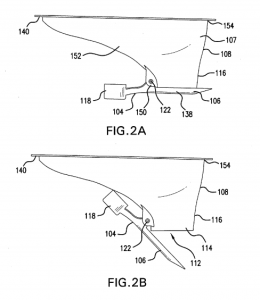This post is one of a series in the #Innovate4Health policy research initiative.
 By Michael O’Keefe
By Michael O’Keefe
Poor sanitation poses an ongoing threat to the health and well-being of people in the developing world. Severe health problems, death, and disease can be directly linked to unsafe hygiene practices that continue to plague many countries. A UN Fact Sheet notes that 2.3 billion people lack access to improved sanitation. Open-air defecation in particular is a widespread concern, as it leads to the spread of communicable diseases. According to the WHO: “Poor sanitation is linked to transmission of diseases such as cholera, diarrhoea, dysentery, hepatitis A, typhoid and polio.”
One way in which these diseases spread is through the lack of proper toilet or latrine facilities. The WHO claims that 2.4 billion people do not have access to such facilities, with 946 million instead practicing open-air defecation.
 In 2012, with support from the Bill and Melinda Gates Foundation’s Water, Sanitation and Hygiene Strategy, and International Development Enterprises (iDE), American Standard Brands developed a potential solution to the hygiene problems stemming from the lack of proper toilet facilities. The SaTo pan – deriving its name from “Safe Toilet” – is an attempt to limit the transmission of disease by ensuring that the toilets being used are closed off from the open air, thus preventing insects or other vectors from communicating those diseases. The basic design is a plastic mold that fits into a concrete base over a pit, which means it can be used even when basic plumbing or sewer infrastructure is absent.
In 2012, with support from the Bill and Melinda Gates Foundation’s Water, Sanitation and Hygiene Strategy, and International Development Enterprises (iDE), American Standard Brands developed a potential solution to the hygiene problems stemming from the lack of proper toilet facilities. The SaTo pan – deriving its name from “Safe Toilet” – is an attempt to limit the transmission of disease by ensuring that the toilets being used are closed off from the open air, thus preventing insects or other vectors from communicating those diseases. The basic design is a plastic mold that fits into a concrete base over a pit, which means it can be used even when basic plumbing or sewer infrastructure is absent.
 Access to proper sanitation and clean water is vital for the health and safety of growing populations in both urban and rural areas. When human feces are not disposed of effectively, it can cause a number of health problems. Chronic illnesses spread by feces, such as enteropathy, encephalitis, and diarrhea, can weaken adults as well as children and prevent them from retaining nutrients, potentially causing health problems for their offspring as well. Even when human waste is disposed of in a pit, rather than left out in the open, disease vectors such as flies can potentially still access it, turning latrines into persistent sources of disease for whole communities.
Access to proper sanitation and clean water is vital for the health and safety of growing populations in both urban and rural areas. When human feces are not disposed of effectively, it can cause a number of health problems. Chronic illnesses spread by feces, such as enteropathy, encephalitis, and diarrhea, can weaken adults as well as children and prevent them from retaining nutrients, potentially causing health problems for their offspring as well. Even when human waste is disposed of in a pit, rather than left out in the open, disease vectors such as flies can potentially still access it, turning latrines into persistent sources of disease for whole communities.
 Invented by Jim McHale, Daigo Ishiyama and Greg Gatarz, the SaTo pan operates much like a trap door, using a counterweight to stay closed except for allowing the passage of waste. The plastic design is cheap and acts as an effective seal over the toilet. In addition to the sanitary benefits, the SaTo pan also acts as a basic safety measure. Because of the nature of some open-pit latrines, young children face the risk of falling inside. When installing SaTo pans in Uganda, one organization reported this as a notable benefit to the communities due to the particular design of latrines in the areas they worked in.
Invented by Jim McHale, Daigo Ishiyama and Greg Gatarz, the SaTo pan operates much like a trap door, using a counterweight to stay closed except for allowing the passage of waste. The plastic design is cheap and acts as an effective seal over the toilet. In addition to the sanitary benefits, the SaTo pan also acts as a basic safety measure. Because of the nature of some open-pit latrines, young children face the risk of falling inside. When installing SaTo pans in Uganda, one organization reported this as a notable benefit to the communities due to the particular design of latrines in the areas they worked in.
The research team at American Standard settled on the SaTo pan concept after observing the open-pit style latrines commonly used in Bangladesh. Before the pans were installed, such latrines remained open to the air at all times, which meant that not only was the smell free to travel, but flies and other insects could enter and exit the pit, carrying a host of diseases with them. As demonstrated in this video, the pan can be “flushed” after use with a pot of water, but otherwise blocks any unwanted traffic such as insects.
 Crucially, the design of the pan allows for potential variations according to local customs and demands, such as using the facilities by squatting or sitting or adapting to the shape of the pit for the latrine. The core concept around which the pan is based is the counterweighted “flapper” itself. The counterweight is specifically set so that the flap remains closed until the additional force of water – not just the waste itself – is poured into the pan. The pour-flush mechanic also creates a liquid seal, with a minimal amount of water remaining on top of the flap after use to help ensure prevention of transmission of insects or gases. This approach, utilizing a basic mechanism while leaving room for responsive adjustments in design, allows the SaTo pan to be adapted globally while maintaining a simple but effective means of providing basic health benefits.
Crucially, the design of the pan allows for potential variations according to local customs and demands, such as using the facilities by squatting or sitting or adapting to the shape of the pit for the latrine. The core concept around which the pan is based is the counterweighted “flapper” itself. The counterweight is specifically set so that the flap remains closed until the additional force of water – not just the waste itself – is poured into the pan. The pour-flush mechanic also creates a liquid seal, with a minimal amount of water remaining on top of the flap after use to help ensure prevention of transmission of insects or gases. This approach, utilizing a basic mechanism while leaving room for responsive adjustments in design, allows the SaTo pan to be adapted globally while maintaining a simple but effective means of providing basic health benefits.
In 2015, American Standard received the Patents for Humanity award from the USPTO for its design of the (then-pending patent application) SaTo pan toilet. The counterweighted trapdoor is significantly more effective than standard squat-hole covers and avoids the risk of blockage that comes with more complex, alternative designs. Utilizing the patented design also allows American Standard to fully gauge the needs of the market, providing the basis for ongoing production and development.
Although American Standard is more generally known as a plumbing manufacturer, the SaTo pan has become a key part of their business structure. American Standard was purchased by the LIXIL Corporation in 2013, and brought within the LIXIL Water Technology (LWT) business unit in 2015. In 2016, LIXIL announced that it was establishing a special unit within LWT devoted to supporting continued development of the SaTo. Currently, three new alternative models of the SaTo pan are in development to meet the varying need of different regions. Although the initial design functions well in areas such as Bangladesh, bringing it to Sub-Saharan Africa presents new challenges, primarily that there is significantly less access to water. As the counterweight system relies on water for its operation, this poses a hurdle to its effectiveness in such regions.
American Standard has been able to use the SaTo pan design as the basis for a broad-ranging business strategy. From 2013-2014, American Standard implemented a donation program, Flush for Good, with each sale of one of its Champion toilets funding the donation of a SaTo pan. 500,000 have been donated to Bangladesh alone. Other donation programs include sending SaTo pans to Nepal after the recent earthquakes and partnerships with NGOs such as UNICEF and Save the Children. By the middle of 2016, SaTo pans had been installed in 14 countries, including Uganda, Haiti, Malawi, Nigeria and the Philippines.
#Innovate4Health is a joint research project by the Center for the Protection of Intellectual Property (CPIP) and the Information Technology & Innovation Foundation (ITIF). This project highlights how intellectual property-driven innovation can address global health challenges. If you have questions, comments, or a suggestion for a story we should highlight, we’d love to hear from you. Please contact Devlin Hartline at jhartli2@gmu.edu.

